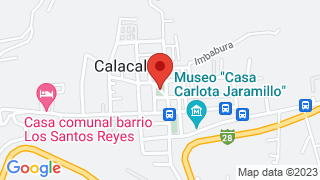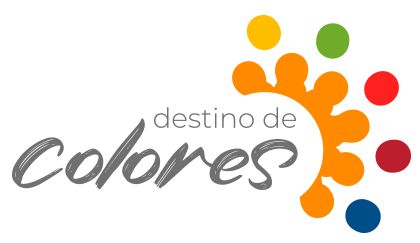Calacalí



Destino de Colores - Colorful destinations of Pichincha
- The colors of Calacalí are those of the rainbow that paint the sky or perhaps they could be the red of the passion of its artists, or the yellowish white of its biscuits.
- Calacalí, Aloasí, Calderón, La Merced, Lloa, Mindo, Machachi, Pacto, Pintag, Pomasqui, Pedro Vicente Maldonado, are part of the Destino de Colores campaign, they are a select group of rural destinations of Pichincha province that offer to tourists a variety of tourism experiences oriented to contact with nature and culture; as well as sustainable and community tourism experiences.
- Prefectura de Pichincha, through the Destino de Colores campaign, promotes the entrepreneurial spirit of Pichincha people.
What should you know about Calacali?
- Calacalí is 17 km to North from Quito, near the Mitad del Mundo City , it is the entrance to the Northwest of the province of Pichincha .
- Its name comes from the lime mines located in that region.
- The mist that continually covers the town like a "white and humid cover" that in the language of the aborigines is called Calacalí, is another theory of the origin of the name of this rural town.
- Calacalí was famous in the past for the smuggling of liquor that for many decades was the axis of its economic development.
- The fertile land of Calacalí produces sweet cane that is one of the ingredients to create liquor.
- Calacalí is a rough diamond embedded in the center of the world, a diamond that tells its story through its landscapes and its people who proudly identify themselves with the true Equator Line.
History of Calacalí
The parish of Calacalí was a pre-Hispanic zone of great importance for the region, especially due to the presence of the Yumbo people (between 800 AD and 1600 AD) that dominated a wide area of territory to the northwest of what is currently the Metropolitan District of Quito.
Calacalí is a very diverse territory that brings together within its geography different and very unique areas such as the Pululahua Geobotanical Reserve or the cloud forest that surrounds Yunguilla.
Nature Reserves in Calacali
- Just 45 minutes to the northwest of the city of Quito, there is a little-known but incomparable natural paradise: the Chocó Andino.
- The Chocó Andino has 285,000 hectares that represent 30.31% of the territory of the province of Pichincha.
- Its cloud forests preserve a large number of emblematic flora and fauna species.
- This area is home to approximately 270 types of mammals, 30% of the total number of birds and 15% of the plant species in the country.
- In this small space you can find animals such as the spectacled bear, the choco toucan, the rooster of the rock, ocelots, olingos, the black-breasted bird, as well as countless amphibians, insects and reptiles.
- Within this area you can carry out different types of activities such as: community tourism, bird watching, ecotourism and adventure tourism.
Pululahua Geobotanical Reserve
- Perhaps one of the few populations in the world that lives in the caldera of a volcano: it is a protected area that allows you to enjoy spectacular landscapes, ideal for observing flora and fauna.
- Its access is made through a detour 500 meters from the Calacalí gas station, or by walking through the Ventanillas viewpoint, located 6 kilometers from the Mitad del Mundo city located in San Antonio de Pichincha.
- It has trails and recreational areas, perfect for taking a walk with the family while enjoying a spectacular view of the crater and caldera of the Pululahua Volcano .
- In the Pululahua biological reserve you can practice trekking, cycling, horseback riding, camping, pinning and other adventure activities.
Yunguilla Cloud Forest Reserve
- 45 minutes from Quito , after surpassing the 0º parallel and ascending to 3000 meters above sea level, it is nestled in the exuberant mountains of the cloud forest to the northwest of the Metropolitan District of Quito.
- Yunguilla is a picturesque town, bounded by Pululahua towards the Andes and by the Maquipucuna and Pahuma reserves towards the coast.
- It is more than a community of coal workers who reconverted their source of work, developed a sustainable , ecological and conservationist option , generating a very positive impact within its inhabitants and becoming one of the few communities that develop sustainable community tourism in the country. .
Original monument of the Middle of the World in Calacalí
- The Middle of the World Museum of San Antonio de Pichincha is located in Calacalí.
- Near Quito, there are four places with monuments that highlight being in the middle of the world: Middle of the World City, the Calacalí town, the Catequilla hill and the San Luis de Guachalá town .
- And it is precisely Calacalí where the first monument of the Middle of the World is located, in the middle of the Equator Square, on Juan José Flores and Simón Bolívar streets.
- The monument, initiated by the geographer Luis Tufiño, was raised in 1936 in San Antonio de Pichincha, to commemorate 200 years of the work of the French Geodesic Mission that arrived in Ecuador, to measure the arc of the terrestrial meridian.
- In 1979, this 10-meter-high monument was moved to Calacalí, that in fact marks the location of the Equinoctial Line more accurately.
House Museum of Carlota Jaramillo
- The house where "La Reina de la Canción Nacional" grew up in Calacalí, was restored by the Fonsal and in 2004 a museum was opened to remember the Ecuadorian singer.
- "Si tú me olvidas", the song that would take her to the glory of popular memory, can be heard when walking through the corridors of his house, where records, guitars, suits and a thousand and one memories attest to the love that Carlota cultivated for through the years.
- Photographs receiving decorations from presidents are not as important as the photographs with her husband who was also the author of "Sendas distintas" , the song that would immortalize their love.
Santa María Magdalena de Calacalí Church, Sucre Park and its central pool
- Unquestionable symbol of faith, possessing great spiritual value dating from 1814, the Calacalí church was remodeled by EL FONSAL (Municipality of Quito).
- In front of the church is the Calacali fountain of colonial origin. This was located previously in the Plaza de San Francisco in Quito and was used by the residents of the capital as a source of water. It was moved to Calacali in 1912.
- The Calacalí park offers a space of tranquility and peace, a park full of history.
Calacalí cemetery and its stone cross
- Adorned with an architecture of white colored elements; In its center there is an area where a stone cross stands proudly. This stone cross would have been carved exclusively to be part of this environment.
- The three points of the cross have a spherical design that has been perfectly carved.
- The stone cross was made in a single body with the same technique as a few others located in the city of Quito, especially in the historic center of Quito.
Ortega Art Temple
- This museum offers three spaces with samples of archeology and anthropology; works by Cristóbal Ortega, plastic artist and founder of the museum; and temporary samples of various creators. On weekends, there are dance and music shows
Gastronomy of Calacali
- Regarding gastronomy, Calacalí offers a very traditional and popular dessert: "La espumilla con hielo ", which is sold in the central park every day.
- You will also find sweet arepas that can be enjoyed on weekends.
- Calacalí biscuits are famous in Pichincha. Doña Gladicita, for example, is a venture with more than 80 years of flavor stories.
Holidays and traditions
Saint Peter and Saint Paul in Rayocucho
- June 29th: In the Rayocucho sector there is a procession to the town chapel, a dance led by the aruchicos and fireworks displays.
Jesus of the Great Power in Yunguilla
August 2nd: This festival is translated into a procession throughout the community, with the participation of dancers dressed as aruchicos, clowns, devils with masks and other characters.

Publicado en:
Publicado por:




